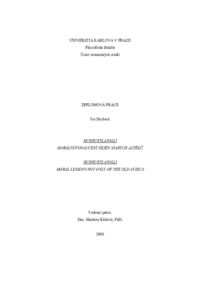Huehuetlatolli - morální ponaučení nejen starých Aztéků
Huehuetlatolli - moral lessons not only of the old Aztecs
rigorous thesis (RECOGNIZED)

View/
Permanent link
http://hdl.handle.net/20.500.11956/22096Identifiers
Study Information System: 75443
CU Caralogue: 990015575360106986
Collections
- Kvalifikační práce [24310]
Author
Advisor
Referee
Korecká, Zuzana
Faculty / Institute
Faculty of Arts
Discipline
Spanish Studies
Department
Institute of Romance Studies
Date of defense
4. 9. 2009
Publisher
Univerzita Karlova, Filozofická fakultaLanguage
Czech
Grade
Recognized
Diplomová práce "Huehuetlatolli - morální ponaučení nejen starých Aztéků" analyzuje z několika různých hledisek tento méně známý literární žánr nahuaského písemnictví. Původní podobu pravděpodobně ústně tradovaných útvarů dnes známe díky sběratelské činnosti dvou španělských františkánských misionářů Andrése de Olmos a Bernardina de Sahagún, kteří se po příchodu do oblasti dnešního Mexika hned na samém počátku koloniálního období zajímali o domorodou kulturu a její tradice. K rozboru mi posloužily texty z knihy VI Historia general de las cosas de Nueva Espaa od Bernardina de Sahagún. V úvodních kapitolách jsou na základě odborných prací mexických i jiných zahraničních badatelů, zejména Ángela Maríi Garibaye, Miguela Leóna-Portilly, Markéty Křížové a dalších, vyvozeny obecné závěry o nahuaské kultuře a vztahu jednoho z nejznámějších předkolumbovských etnik Aztéků k tomuto fenoménu. Je zde také popsána sběratelská aktivita obou výše zmíněných misionářů a její výsledky. Následně jsou uvedeny argumenty, na jejichž základě byly jako podklad pro tuto práci vybrány texty v konečné podobě zpracované Bernardinem de Sahagún. Pro poskytnutí uceleného pohledu na nahuaské písemnictví, za jehož nedílnou součást jsou huehuetlatolli považovány, bylo rovněž nutné uvést jeho klasifikaci a některé základní charakteristiky.
The diploma thesis "Huehuetlatolli - moral lessons not only of the old Aztecs" examines this rather unknown genre of Nahua literature from various viewpoints. The original form of these probably only orally transmitted traditions is nowadays known due to the records made by two Spanish Franciscan missionaries Andrés de Olmos and Bernardino de Sahagún. Both of them started showing interest in the indigenous cultures and traditions immediately after arriving in the area of the present Mexico at the beginning of the colonization period. The analysis presented in this work is based on the Volume VI of the book Historia general de las cosas de Nueva Espaa written by Bernardino de Sahagún. The introductory chapters offer a rather general description of Nahua culture and its relationship to the most famous pre-Columbian ethnic group - the Aztecs. This information was largely obtained through the study of texts of both Mexican and foreign scholars such as Ángel María Garibay, Miguel León-Portilla, Markéta Křížová, and others. The text also mentions how the missionaries Andrés de Olmos and Bernardino de Sahagún collected the texts. I also provide arguments why I chose texts edited by Bernardino de Sahagún as a source of this thesis. Additionally, it was also important to classify and mention the main characteristics...
